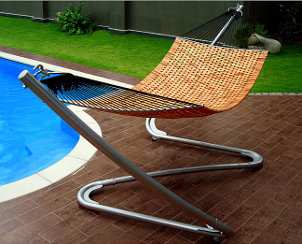Hammocks Buying Guide
by Staff Writer
Create comfortable outdoor seating with hammocks and swings and turn your patio and garden into more living space. Hammocks are the classic image of relaxation, but shopping for hammocks and swings can be far from relaxing, especially with the many different types available. Let this buying guide help you find the perfect additions to your outdoor furniture that will bring the luxurious relaxation you have always imagined.
Buying a Hammock:

Shop Hammocks and Swings ▸
- General hammock tips:
You can find fabric and rope hammocks, hammock chairs and portable hammocks for your patio and garden. Each hammock style has its qualities, and one is sure to be perfect for your patio.
- Fabric hammocks:
Fabric hammocks are some of the most comfortable hammocks available. Quilted fabric hammocks, usually made of cotton, are one of the most luxurious additions to patio furniture. Usually, if a hammock states that it is appropriate for sleeping, you can bet that hammock is made from fabric. Hammocks made of cotton are comfortable, breathable and good-looking, but they're not very weatherproof, and the colors can fade. Cotton is also prone to mold and mildew, so cotton hammocks should not be left outside in bad weather. Polyester hammocks are durable and weather-resistant, and they can be just as comfortable as cotton hammocks. Canvas hammocks are the most durable fabric hammocks for outdoor use.
- Rope hammocks:
Rope hammocks are classics, but relaxing on a rope hammock can be tricky. If you use a rope hammock for a long period, you could end up with crisscross patterns where your skin contacts the ropes, and your hands and feet can fall through the ropes. Aside from those minor dangers, the material of the rope hammock can greatly affect its comfort and durability. Cotton rope hammocks are comfortable because cotton stretches and conforms to your body shape, and it feels good against your skin. Polyester-rope hammocks are more durable than cotton and fade less in direct sunlight.
- Hammock chairs:
Hammock chairs are a great alternative to full-size hammocks, especially if you are tight on space. Hammock chairs only require one point of support. They are made from the same materials as other hammocks. Hammock chairs are a great option for families with children; they are more stable than other hammocks, and they are more difficult to fall out of, making them ideal for kids.
- Portable hammocks and stands:
Most hammocks can be considered portable outdoor furniture. When you buy a hammock stand, you are free from tying your hammock between two trees, but there are hammocks and frames that are even more portable. Folding or collapsible hammock chairs are the most popular. The frame folds for storage and moving, making these hammocks great for picnics and the beach. Even hammocks that are strung between two trees are portable; you can take them down and put them back up wherever you want. If you can, purchase a hammock set that includes the stand so you know they'll fit together perfectly.
Buying a Porch Swing
- General swing tips:
Porch swings are a sign of true relaxation, but porch swings aren't the only swings available for patio furniture. There are several types of swings to choose from, and they can be made from wood, painted wood, resin wicker, plastic or metal. Familiarize yourself with the advantages and disadvantages of each type and material before selecting the swing for you.
- Hanging porch swings:
Hanging porch swings are the classic swing that hangs from your porch or awning. They come with hanging chains and hooks for installation. Make sure you have a large enough area and a strong enough support to hold a porch swing. Most porch swings are 4 to 5 feet long and should fit any standard porch area.
- Yard swings:
Yard swings include a frame so they can stand alone wherever you want to put them. Some yard swings have a canopy and cushioned seats for added comfort. Watch out for wind if you want a canopy swing; the wind can pick them up and move them, which often damages the swing.
- Gliders:
Both hanging porch swings and stand-alone swings have glider versions for an easier, smoother swing.

















